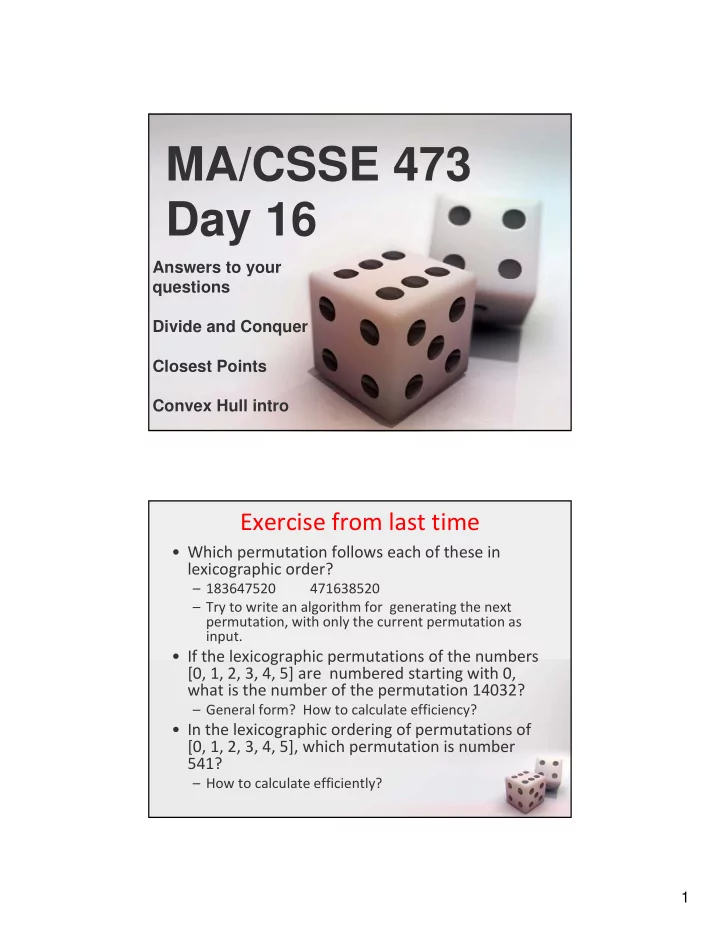

MA/CSSE 473 Day 16 Answers to your questions Divide and Conquer Closest Points Convex Hull intro Exercise from last time • Which permutation follows each of these in lexicographic order? – 183647520 471638520 – Try to write an algorithm for generating the next permutation, with only the current permutation as input. • If the lexicographic permutations of the numbers [0, 1, 2, 3, 4, 5] are numbered starting with 0, what is the number of the permutation 14032? – General form? How to calculate efficiency? • In the lexicographic ordering of permutations of [0, 1, 2, 3, 4, 5], which permutation is number 541? – How to calculate efficiently? 1
Gray Code and Hamiltonian Cycles • A Hamiltonian cycle in an undirected graph is … • Hypercubes (picture is from Wikipedia): • Binary ‐ reflected Gray Code is a Hamiltonian Cycle of a Hypercube: DIVIDE AND CONQUER 2
Divide ‐ and ‐ conquer algorithms • Definition • List examples seen in prior courses or so far in this course Today: Closest Points, Convex Hull DIVIDE AND CONQUER ALGORITHMS 3
Divide ‐ and ‐ conquer algorithms • Definition • Examples seen prior to this course or so far in this course Q1 Closest Points problem • Given a set, S, of N points in the xy ‐ plane, find the minimum distance between two points in S. • Running time for brute force algorithm? • Next we examine a divide ‐ and ‐ conquer approach. 4
Closest Points "divide" phase • S is a set of N points in the xy ‐ plane • For simplicity, we assume N = 2 k for some k. (Otherwise use floor and ceiling functions) • Sort the points by x ‐ coordinate – If two points have the same x ‐ coordinate, order them by y ‐ coordinate – If we use merge sort, the worst case is Ѳ (N log N) • Let c be the median x ‐ value of the points • Let S 1 be {(x, y): x ≤ c}, and S 2 be {(x, y): x ≥ c} – adjust so we get exactly N/2 points in each subset Closest Points "conquer" phase • Assume that the points of S are sorted by x ‐ coordinate, then by y ‐ coordinate if x's are equal • Let d 1 be the minimum distance between two points in S 1 (the set of "left half" points) • Let d 2 be the minimum distance between two points in S 2 (the set of "right half" points) • Let d = min(d 1 , d 2 ). Is d the minimum distance for S? • What else do we have to consider? • Suppose we needed to compare every point in S 1 to every point in S 2 . What would the running time be? • How can we avoid doing so many comparisons? 5
Reference: The Master Theorem • The Master Theorem for Divide and Conquer recurrence relations: For details, see Levitin • Consider the recurrence pages 483-485 or T(n) = aT(n/b) +f(n), T(1)=c, Weiss section 7.5.3. where f(n) = Ѳ (n k ) and k ≥ 0 , Grimaldi's Theorem • The solution is 10.1 is a special case of the Master Theorem. – Ѳ (n k ) if a < b k – Ѳ (n k log n) if a = b k – Ѳ (n log b a ) if a > b k We will use this theorem often. You should review its proof soon (Weiss's proof is a bit easier than Levitin's). After recursive calls on S 1 and S 2 d = min(d 1 , d 2 ). 6
Convex Hull Problem • Again, sort by x ‐ coordinate, with tie going to larger y ‐ coordinate. Recursive calculation of Upper Hull 7
Simplifying the Calculations We can simplify two things at once: • Finding the distance of P from line P 1 P 2, and • Determining whether P is "to the left" of P 1 P 2 – The area of the triangle through P 1 =(x 1 ,y 1 ), P 2 =(x 2 ,y 2 ), and P 3 =(x 3 ,y e ) is ½ of the absolute value of the determinant 1 x y 1 1 1 x y x y x y x y x y x y x y 2 2 1 2 3 1 2 3 3 2 2 1 1 3 1 x y 3 3 • For a proof of this property, see http://mathforum.org/library/drmath/view/55063.html • How do we use this to calculate distance from P to the line? – The sign of the determinant is positive if the order of the three points is clockwise, and negative if it is counter ‐ clockwise • Clockwise means that P 3 is "to the left" of directed line segment P 1 P 2 • Speeding up the calculation Efficiency of quickhull algorithm • What arrangements of points give us worst case behavior? • Average case is much better. Why? 8
Recommend
More recommend